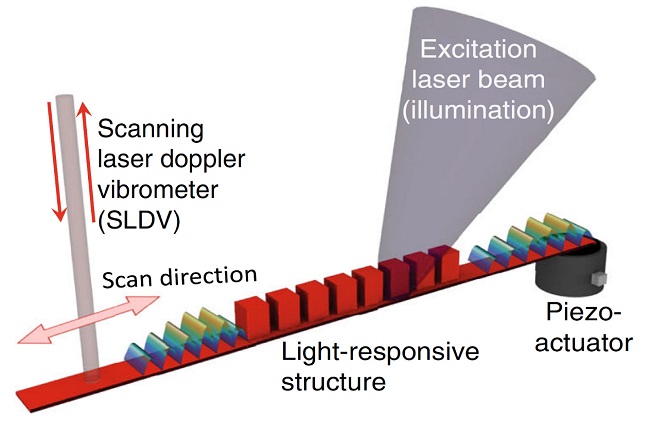LILLE, France, Aug. 20, 2020 — An international team from the Institute of Electronics, Microelectronics, and Nanotechnology (IEMN), the Polytechnic University of Turin, Empa, and the Norwegian University of Science and Technology has found a way to create adaptable metamaterials. The researchers demonstrated a polymeric, 3D-printed, elastic metamaterial whose transmission spectrum could be deterministically tuned by illuminating it in a targeted manner with a laser beam.
Using a photopolymerization-based 3D-printing technique, the researchers made a light-responsive elastic metamaterial consisting of a linear array of squared pillars arranged on a slab waveguide. The waveguide was made out of a polymer that was charged with molecules reactive to blue light. The researchers used a piezoelectric transducer to send lightwaves through the metamaterial.

Schematic representation of the adaptable photosensitive elastic metamaterial. Courtesy of IEMN.
By selectively illuminating the pillars of the waveguide with a blue laser, the researchers were able to modify the elastic properties of the metamaterial, which resulted in the blocking of certain frequency ranges. They demonstrated that the metamaterial could essentially act as a filter whose operation could be controlled by adjusting the location and duration of the laser light.
Metamaterials are designed with a particular geometric structure in order to obtain new physical properties, and can alter the propagation of elastic waves so as to reduce or block them over a certain range of frequencies. In this way the material functions as a filter. However, despite a variety configurations, most existing metamaterials display a frequency response that cannot be tuned once the structures are fabricated. To modify the filtered frequency range, it is necessary to create another metamaterial.
This lack of adaptability historically limits the practicality of their application.
In this work, the vibration eigenmodes of individual resonant pillars were affected by a local illumination in such a way that the overall metamaterial bandgap could be significantly widened. These effects occurred within a one-minute time range and were fully reversible. The reversible doubling of the width of an existing frequency bandgap upon selective laser illumination was demonstrated and shown to provide an elastic-switch functionality with a one-minute lag time, over 100 cycles.
These results are a first step toward adaptable metamaterials for filters, waveguides, resonators, switches, beamsplitters, and other devices.
Their proposed structure, the researchers said, constitutes only one example of a new class of active elastic metamaterials that could be achieved by applying 3D-printing techniques to photocurable polymers containing light-active units. Depending on the absorption spectrum of the polymer, the light-responsivity could be selectively improved at other optical wavelengths.
The researchers plan to study the properties of this device on a smaller scale, which could make it possible to achieve reaction times on the order of a second.
The research was published in Nature Communications (www.doi.org/10.1038/s41467-020-16272-y).